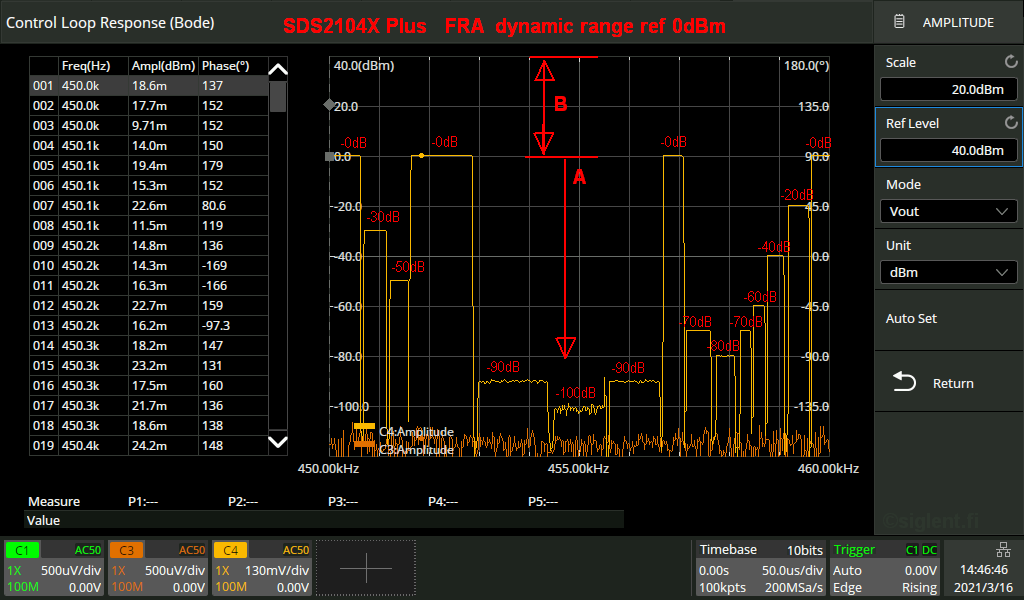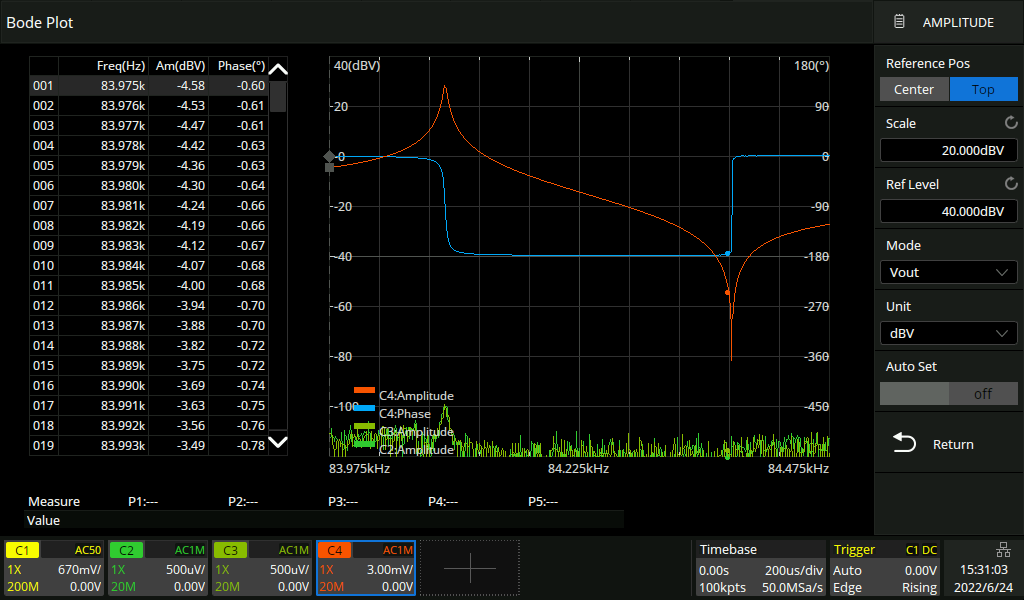Thanks for the replies and compliments.
The Bode Plot in the Siglent is slow, especially at low frequencies.
Like Performa said, it uses frequency selective algorithm,
I djust did some more tests and I can confirm the speed is frequency dependent indeed (and will update the future comparison document):
[ Attachment Invalid Or Does Not Exist ]
That makes it have very good dynamic range and more robust if you are not working in a Faraday cage.
Great, but I would have wished that the user could choose to have such strategies in place or not. In my test case (and I think in many user's test cases) a Faraday cage neither special strategies to deal with very low signals or wide dynamic range are needed. Unless such special situations apply, I would rather like the instrument to be more responsive.
Your complaint about not being able to set fine steps for the amplitude axis has aready been addressed in the SDS2000X HD and will be available in the next SDS2000X Plus firmware. We can now set the scale in 1 dB increments.
Good to know. I don't own that HD scope, but once the firmware update for the SDS2000X Plus is out that fixes this and I have been able to test it, I'm happy to update my comparison document!
Your complaint about not being able to have a look at the time domain view has aready been addressed in the SDS2000X HD and will be available in the next SDS2000X Plus firmware.
Same as above!
In your table there is no information if Siglent was tested using automatic level control (ALC), on or Off (In Siglent "language" it is: Channel Gain: Auto or Manual)
It affect to speed some amount. Naturally because when ALC os ON, after every single frequency step it need check signal level. It is capable to adjust full dynamic range and independently for every channel in use, what is from noise level to max, around -100dBm to 42dBm // -113dBV to 29dBV. Step from minimum to maximum can happen in every single frequency step.
Naturally if use manual, then user need first find max level so that set channels V/div so that signal stay enough under clipping level.
If need test circuits where do not need high dynamic range least I use mostly Manual. Example if 50ohm system and 0dBm is max level. Just 100mV/div and there is still over 60dB dynamic range down from this 0dBm. Even more, depending how much we accept noise affect/reduce level accuracy. With 100mV/div 50ohm BodePlot noise level is somewhere below -80dBm (depending frequency)
If you put these equipments to bit more challenging tests it can tell much more. If compare just using simplest possible tests all can do these simple kind of RC filter class tests if need tell students what is BodePlot. Or just how fast it can plot.
Here some tiny and simple examples.
First one is simplest RC. There is cascaded LPF and HPF. CH3 after HPF and CH2 and 4 bit different position near final. All can do this. (except only Siglent 3 channels simultaneously. But dynamic range is still very easy)
.png)
Then next one is perhaps bit more challenging least to some of oscilloscopes what have BodePlot (or Freq. Response Analyzer or Control Loop Response Analyzer)
In this next image below. Playing with attenuator as DUT. Signal to DUT is 0dBm. As can see when attenuator is 0dB it is. Then attenuator down to 100dB and Result is -100dBm.
As can see frequency here was around 455kHz for look dynamic range if measure and characterize example typical 2nd or 3rd IF filters in some analog receiver. 100dB dynamic down from 0dBm is not at all bad when we talk just basic level oscilloscope.
As can see there is also one channel open for display just noise level. (also note explanations below image)

(in this image I do not remember at all what was FW version but far below today versions)
NOTE: In this time when I did this I have big troubles with attenuator control signals so it is as it is... and after then never made repeat using adjustable good HP step atten.
But, I know this attenuator steps have less than +/-0.5dB error 0 to 80dB and less than +/- 1dB >80 to 110dB.
And now if there is filter as DUT what have stop band attenuation -100dB then result is same...
This level range marked as A and B in picture contain full FRA 140dB dynamic range. But naturally with internal 50ohm can not. Then need external load. (this may happen if example DUT have also amplification. With Passive DUT and Siglent generaton, full dynamic range is of course more low because max output level)
Then this next. This is made using SDS2000X HD but it do not matter here "anything". Because resolution is resolution and it do not directly affect dynamic range itself. HD model noise level is tiny bit better than 2kX+ but if we look whole dynamic range this difference is nearly nonsense in this case. (So, afaik, SDS2kX+ can easy do this same)
Here is tested 84.050kHz high quality vacuum tube type quarz resonator. As can see even Siglent FRA frequency resolution is just borderline or better say not enough (look this fs and fp points level difference... f resolution for fp peak is clearly/barely just enough but for fs there is not enough frequency resolution so it is just one step and now it depends if this step frequency is just perfect or 0.5Hz off what may do big difference in level.
Other channels (2 and 3) are just for give imagination of noise level. And there can see also crosss talk. As can see when CH4 level is most high (resonator highest peak) also it can see over CH2 and 3 noise level (>10dB peak). Still over 120dB distance.

I do not know how are these others but least Siglent is based fully to primary data table what it produce doing sweep. (if select data table to display this is only reduced version from primary table) Bode traces display is only graphic "window" to this primary data table. If data is outside of display window when it sweep, it do not matter anything, result go still to primary table (just move/change your "window" vertical pos and scale to see it.) Sad it can do only this in vertically, not horizontally (not pan and zoom horizontally). It is not "display plotter" is is database plotter. Then you adjust your display window how you want. (exept if you want use this "blond" method Auto adjust). Also internal data table(s) have full resolution (not truncated or rounded as in visible table). This primary table can take out example using .CSV format. (also it can read back to scope for later look again with B.)
Also, Siglent make possible to use external Siglent generators what give lot of more features. Example test circuits what convert frequency. (DUT in and out frequencies are different). In some of this kind of cases it is very important to listen and measure wanted frequency and not example mirror freq. So freq selectivity may have also other aspects than just reduce "noise" etc.. Some simplest BodeToy machines may measure even what ever... just wide band amplitude what may include all dirties and mess. Also using dual channel generator for FRA make possible to use different levels for reference channel and DUT inputs, for example reduce oscilloscope channels internal cross talk effect when DUT in level is high but DUT out level is very very low... example with high quality IF filters stop band levels or specially if filters are higher freq where cross talk may be much more problem.
But, still also I hope Siglent can later implement "fast mode" for simplest circuits Bode just for fast sweep some RC filter where do not need anything but find signal level and phase just without any more sophisticated things. Just like we old time did "Bode" with sweeper, scope and detector (or even logamp/detector because with linear scale reading from scope screen is... totally poor.).
(eta: corrected some most bad typing errs)